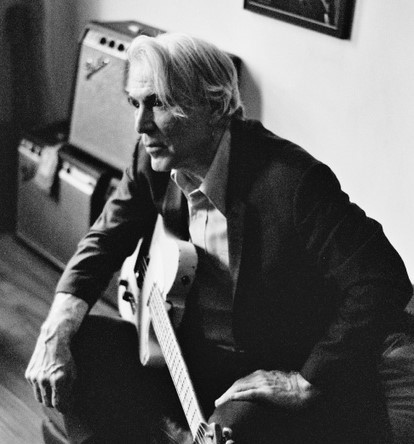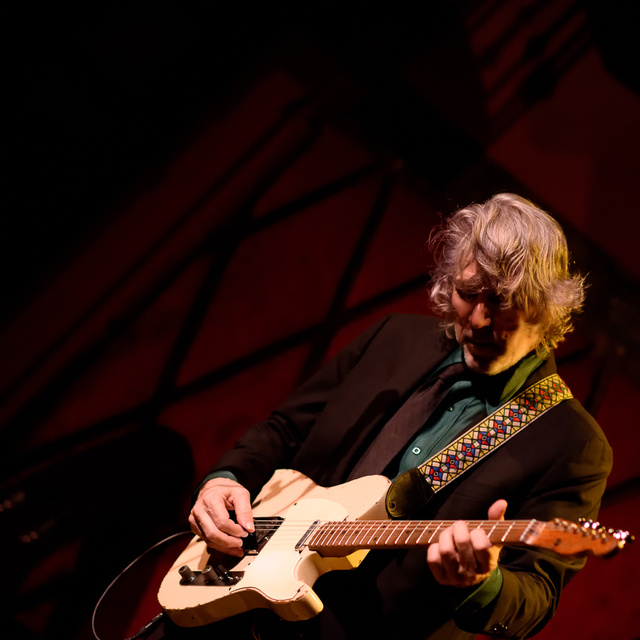Jim Campilongo has been called “an American treasure” by Billboard and the “sultan of twang” in The New Yorker. In 2013, Fender honoured him by releasing the Jim Campilongo Signature Telecaster, a 50-unit reproduction of the 1959 Tele from which he’s been inseparable throughout a lifelong career that has presented opportunities to play with Charlie Hunter, Burning Spear, Cake, Martha Wainright, J.J. Cale, Nels Cline, and of course The Little Willies, a band he co-founded with Norah Jones.
His most recent collaboration, Two Guitars with Luca Benedetti, earned raves from music press across the globe. Speaking of press, he also pens the column “Vinyl Treasures” for Guitar Player magazine. Playing in an inimitable style that can pivot from country-swing to jazz on a dime, he is considered the premier exponent of the Telecaster guitar and all the musical history it represents. Campilongo graciously spent some time with us to discuss the other main ingredient in his signature tone — Celestion loudspeakers — not to mention chronicle his inspirations and offer some must-hear advice on career and practicing.
When and why did you first know you wanted to play electric guitar?
Well, I’d been listening to things like The Beatles and Jimi Hendrix since I was just a kid. When I was about 15 and growing up in South San Francisco, I was living and breathing guitar, but in the information void of that era. You couldn’t just Google things. My mother told me she worked with a guy who played guitar. I called him and said, “I don’t know what kinds of guitars and amps I like.” I think I was borrowing a Teisco electric at the time and had a Kalamazoo amp.
Did he point you in the right direction?
He asked me what guitarists I liked. At the time, I named Eric Clapton and Cream. I also mentioned Hendrix and Ritchie Blackmore of Deep Purple. This guy goes, “Oh, you’ll like Marshall amps.” Ironically, I’ve never owned one!
What amp did you end up with?
By chance I got a Fender Twin. After two or three more years, I’m getting good enough to play covers like “China Grove” and “Two Tickets to Paradise,” that kind of thing. I went through the trends in the ’80s — Gallien-Krueger, guitar synthesizers — but I always came back to Fender. To me, the Telecaster and a Fender amp just is the sound of the electric guitar. And then there’s Celestion!
Tell us more …
At one point I started playing through a Fender Princeton Reverb amp. I was used to Twins and the Vibrolux, and it felt like it was lacking a little headroom compared to those. It was fine if you miked it. So, I took it down to the Amp Lab, run by an amazing tech named Keith Reinegger. Keith said he really liked putting a Celestion G10 in a Princeton. I said, “Do it!” The next day I had a gig at the Make Out Room in San Francisco, and the amp just became this roaring little animal that had incredible dynamic range. I still have three Princetons with G10s in them.
Your playing is known for a lot of dynamic and stylistic range. Do you find the G10 a good fit in that regard?
What I like about Celestion speakers is first, they sound great right away. There’s no breaking in — they sound great as soon as you hit a note. It’s like you can drive the Indy 500 right away without doing test laps. I did a solo record in 2010 called Orange, and on the eve of a recording day I’d done a gig where I’d blown the stock Fender speaker in my amp. I replaced it with a G10 and many of the tracks on that record feature that amp.
Second, Celestion speakers are not super expensive, though I’d still use them if they were. I like them that much.
Last but not least, they have a really nice jazz sound but also a full low-end, and I can go from that to pretty twangy. In that respect I think they’re more versatile than, say, a Jensen driver.
It’s interesting that you say their jazz tone is pleasing, because a lot of enthusiasts equate Celestion with British rock and roots rock.
True, but what I think of as a jazz sound is not a Gibson ES-175 through a vintage Ampeg or Roland Jazz Chorus amp. Not to criticize Joe Pass, for crying out loud, but the jazz sound I like has a little more sass to it — like, if Louis Armstrong were a guitarist, he wouldn’t be playing an ES-175. A Princeton with a G10 inside has just the right amount of softness when I want it.
You’re known for being a minimalist about effects and technology …
Pretty much. I like the control of the relationship with my amplifier, particularly in terms of my right hand. If everything gets compressed, as it can with effects pedals, I feel like my pick attack is neutered. With minimal circuitry in between the guitar and amp, I could be set at 10 and get different tones depending on how I play. That’s another thing I like about the Celestion G10 — it’s very touch sensitive. The speaker assimilates my intentions accurately.
Let’s talk about your guitar heroes.
Let me tell you, living in the Italian-Irish suburbs of South San Francisco in the 1970s and discovering Eric Clapton with Cream — that was like striking gold. Now, his body of work was not as pyrotechnic as, say, Jeff Beck. I would listen to Blow by Blow all day then hear it coming from cars when I left the house. It wasn’t just for guitar nerds. But Clapton had such a robust sound, and there was a swing to his playing that isn’t talked about much anymore. That led me to Albert King, Freddie King, and Robert Johnson, which in turn led me to Roy Buchannan. Roy played through a Fender amp, which led to my buying my first one.
What do you think great guitarists have in common, regardless of genre?
When I learned guitar, one of the main priorities was, do you have your own thing? Jimmy Page has a thing. Eric Clapton does. Jeff Beck does. John McLaughlin certainly does. Jesse Ed Davis had his own thing, like on “Doctor My Eyes” with Jackson Browne. You hear it for the first time and go, “Who is that guy?” Whereas I can be in Bed Bath & Beyond and hear yet another invisible guitar solo. There’s a lot of technically proficient material out there that has no personality.
You also teach. What practice guidance do you give your students?
Great question. I have a lot of students who are a little apprehensive at first. Maybe they’re in their 40s, with kids and a job, and trying to get back into playing music. They’ll tell me, “I promise to practice two hours every day, Maestro Jim!” I’ll say, “Well, you can, but why not shoot for five or ten minutes at first?” Some get disappointed that I’m not being a taskmaster, but the best practice is the kind you’ll actually do. Sometimes the devil wakes up before me, and I just want to make a grilled cheese sandwich and watch Black Mirror. But if I commit to even five minutes, every day, at roughly the same time, I often become engaged and a half hour or more goes by and maybe I’ve learned a new section of a song.
How about advice on the career front?
Do one thing for your career every day. Learning a new riff or tune doesn’t count. So, I write for a magazine. I have a Patreon page. I give lessons over Zoom. I book gigs and travel. I organize set lists and get them to bandmates in advance. Let’s say I put a poster for an upcoming gig on Instagram. There — I did my one thing. In a month, you will have done 30 things, despite if you were tired that day, despite if you felt embarrassed about promoting yourself, despite anything.
Above all, have fun. I still remind myself of this if, say, I turn up to a gig and there are only six people in the audience. Having fun opens the door to so many solutions. And if you’re not having fun, what are you doing?



